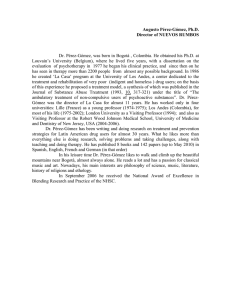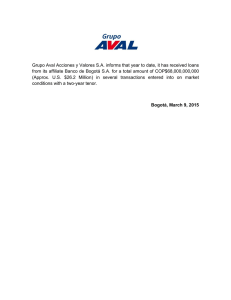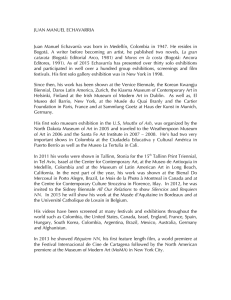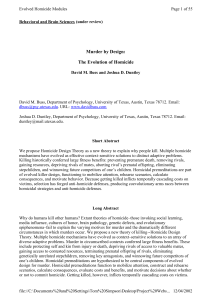BOGOTÁ PROTOCOL
Anuncio
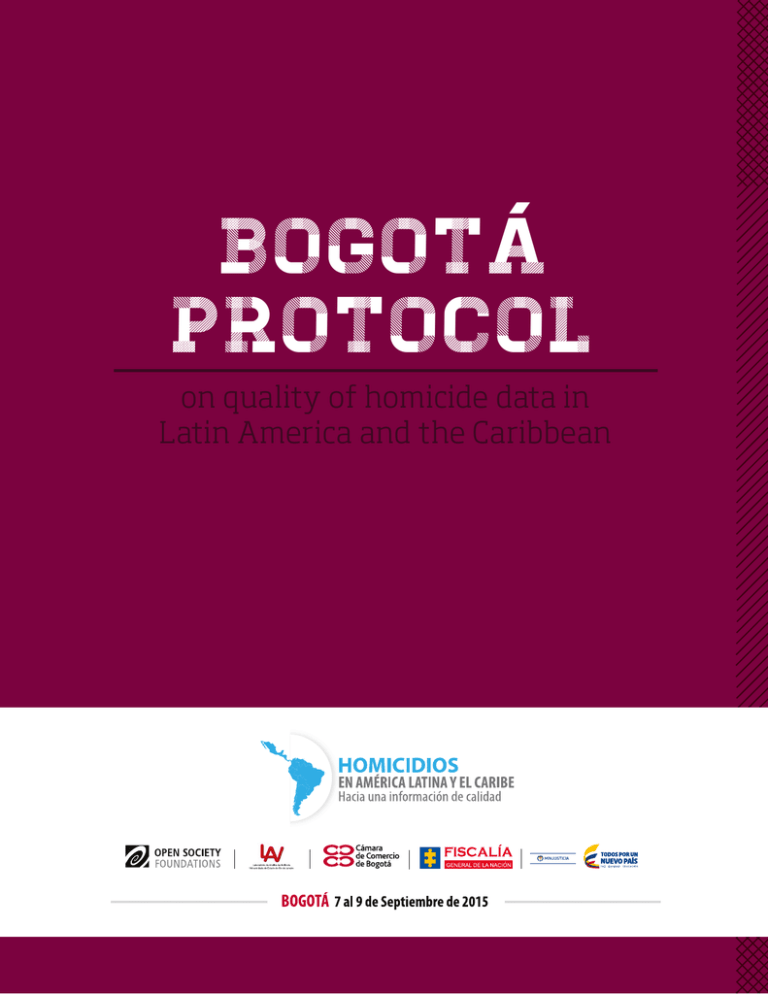
BOGOTÁ PROTOCOL on quality of homicide data in Latin America and the Caribbean BOGOTÁ PROTOCOL 2 ON QUALITY OF HOMICIDE DATA IN LATIN AMERICA AND THE CARIBBEAN INTRODUCTION The Bogotá Protocol on Homicide Data Quality in Latin America and the Caribbean establishes several technical criteria whose implementation reflects a high level of validity, reliability, and transparency. This protocol is destined to serve as a reference for institutions that produce official homicide data and for national or local governments. There are two main types of official sources on homicides: a - those arising from death certificates; and b - those based on crime records. 1 The goal is not to generate new information systems nor modify the categories of existing systems, but rather, drawing on those categories, to generate an integrative concept of homicide that allows for the convergence of the different sources. This protocol was designed to determine the quality of data and to provide guidance for improvement. At the same time, this instrument is a guide for civil society to be able to monitor data quality in the countries of the region. Having valid and reliable data is essential for designing and evaluating homicide prevention and reduction policies. Moreover, data subjected to rigorous and uniform quality criteria facilitate international comparability. The criteria proposed are complementary, gradual, and cumulative. Accordingly, a country or data-producing institution could meet some of these criteria but not others, such that this exercise would indicate what they could improve in the future. Various institutions and agencies process and publish data from the two kinds of sources in the different countries. It is also common for several national institutions to disseminate data based on a single type of source. 1 BOGOTÁ PROTOCOL ON QUALITY OF HOMICIDE DATA IN LATIN AMERICA AND THE CARIBBEAN This proposal was framed at the Conference on Quality of Homicide Data in Latin America and the Caribbean held in Bogotá, Colombia, September 7 to 9, 2015, ande included the participation of more than 90 persons from 12 countries. The profile of participants contemplated members of criminal justice and health institutions, as well as institutes of statistics, academics, members of civil society and multilateral agencies. Accordingly, this document was drawn up as a joint initiative of civil society and public authorities. The specific thresholds proposed for the criteria took into account the current reality of the two types of sources of data in the region, reflected in the experience of the participants and in a technical study2 that assessed data quality over the last few years. The limits established for each criterion tend to be better than the average performance of the countries of Latin America and the Caribbean, but not so high as to be unattainable in the regional context. In the future, the percentages established here could undergo changes based on new technical studies and on the gradual improvement in data quality. The criteria and thresholds proposed are grouped in eight thematic areas according to their content and they are applicable simultaneously to the two types of sources – death certificates and criminal records – unless otherwise stated. The eight proposed areas are as follows: 1. RECORDING UNIT The recording unit for homicides should be the victim. Thus, when two or more persons are victims of homicide in the same incident, each of them should be recorded individually. Nonetheless, the connection among victims who died in a single episode should be preserved. 2 “Homicide Data Quality in Latin America and the Caribbean” (LAV-UERJ, 2015). Available at: http://conferenciahomicidiosbogota2015.org 3 BOGOTÁ PROTOCOL 4 ON QUALITY OF HOMICIDE DATA IN LATIN AMERICA AND THE CARIBBEAN 2. DEFINITION OF HOMICIDE Homicide is defined, for the present purpose, as the death of a person caused by an intentional assault by another person or persons. Hence, unintentional and accidental homicides are excluded as are attempted homicides. 3 Included are deaths by assault in the context of international wars, internal conflicts, and civil disturbances. In addition, deaths by assault committed by public agents in the exercise of their professional duty, even when lawful, are considered, along with deaths that occurred in the exercise of the right to self-defense by anybody. Consequently, this notion of homicide is not limited by its legal definition, which varies from country to country and often includes several specific crimes, but by a general concept that does not depend on the legality or illegality of the facts. This option maximizes international comparability, is consistent with the objective of minimizing deaths due to assault regardless of their legality and avoids the delay that results from waiting for the certainty of a judicial decision. For the data originating from death certificates the operative concept of homicide is identified with the sum of the categories of WHO’s International Classification of Diseases (ICD-10) related to “death by assault,” 4 “death due to legal intervention,” 5 “death by war operations” 6 and the respective deaths due to sequelae. 7 For the data from criminal records, the definition proposed here approximates the sum of the following codes set forth by the International Classification of Crimes for Statistical Purposes (2015): “intentional homicide,” 8 “unlawful killing associated with armed conflict not amounting to a war crime,” 9 and “war crime.” 10 Nonetheless, this Classification is based on the criterion of illegality, in contrast to the concept of homicide set forth here. Death by abandonment is not included in the definition, unless it is intentional, as would be the case of prisoners of war who are left to die of hunger, which would be considered an intentional homicide. 4 Codes 85-Y05; Y07-Y09. 5 Code Y35. 3 Code Y36. Codes Y87.1; Y89.0; Y89.1. 8 Code 0101. 9 Code 0107. 10 Code 01013, but only in those cases that result in death. 6 7 BOGOTÁ PROTOCOL ON QUALITY OF HOMICIDE DATA IN LATIN AMERICA AND THE CARIBBEAN 3. MINIMAL INFORMATION TO BE RECORDED The record of each homicide should include information on the victim, the incident, and the alleged perpetrator. The minimum set of information that should be recorded is as follows 11 : A - Victim: 1. Single identifier 2. Sex 3. Date of birth or, if not available, approximate age 4. Nacionality 5. Civil status 6. Schooling 7. Profession or occupation 8. Place of residence, with the greatest detail possible 9. Additional characteristics related to groups at risk in light of local context, such as race and/or ethnic group, sexual orientation, gender identity and socioeconomic status, among others. B - Incident: 1. Date and time of assault or, lacking that information, of the finding of the corpse 2. Date and time of death 3. Weapon/mechanism/means with which the homicide was committed 4. Number of other fatal victims 5. Number of alleged perpetrators (only applies to data from criminal records) 6. Place of assault, with the greatest possible detail 7. Type of place of assault: public or private 8. Motive of the assault (only applies to data from criminal records) 9. Description, in open field, of the circumstances of the death C - Alleged perpetrator (only applies to data from criminal records): 1. Sex 2. Date of birth or, if not available, approximate age 3. Nationality 4. Relationship between victim and alleged perpetrator 5. Profession or occupation 11 It is recommended that to the extent possible the variables cited here be codified using consistent categories 5 BOGOTÁ PROTOCOL 6 ON QUALITY OF HOMICIDE DATA IN LATIN AMERICA AND THE CARIBBEAN 4. MISSING DATA AND INDETERMINATE CASES As a way to assess data quality, there should be a maximum percentage of missing information and indeterminate categories. The following criteria are established: a - A maximum percentage of 1% of homicide victims whose sex is unknown. b - A maximum percentage of 5% of homicide victims whose age is unknown. c - A maximum percentage of 10% of homicide victims about which the municipality where the assault occurred is unknown. d - A maximum percentage of 10% of ambiguous categories for classification of deaths that may or may not contain homicides. This is operationalized in each type of source as follows: d.1 - Death certificates: a maximum percentage of 10% of deaths due to external causes of unknown intent 12 in relation to total deaths due to external causes. d.2 - Criminal records: a maximum percentage of 10% of violent deaths classified in residual and temporary categories that may include homicides (corpse found, death to be clarified, etc.) as a percentage of all homicides plus those residual and temporary categories. e - A maximum percentage of 5% of homicides by unspecified means in relation to the total number ofl homicides. In the case of death certificates, there are specific codes for unspecified means. 13 In the case of criminal records codes vary from country to country. 12 13 Codes Y10 to Y34 and Y87.2 of the ICD-10. Codes for homicide by unknown means: Y09; Y35.7; Y36.9. All codes for homicide: X85-Y05; Y07-Y09; Y35; Y36. BOGOTÁ PROTOCOL ON QUALITY OF HOMICIDE DATA IN LATIN AMERICA AND THE CARIBBEAN 5. CONVERGENCE AMONG SOURCES A high degree of convergence among homicides obtained from criminal records and from death certificates, reported by various public agencies, is necessary for ensuring the validity and reliability of both sources. 14 Accordingly, a maximum limit of 20% discrepancy is established between the records from those two sources. 6. MECHANISMS FOR VERIFICATION AND VALIDATION OF DATA As part of the strategy for verification and validation of data, a mechanism or technical body is required in order to undertake review processes based on methodologies that include cross-referencing homicides, victim by victim. This process should make use of all official sources and possibly other external sources. The above mentioned body must include the participation of public servants, academics and members of civil society specialized in the matter, and will formulate actions to improve the quality of the information based on detected inconsistencies. Convergence results from the high quality of the sources of information according to their own objectives and methodologies. Nonetheless, there is no intention to standardise data or information systems. 14 7 BOGOTÁ PROTOCOL 8 ON QUALITY OF HOMICIDE DATA IN LATIN AMERICA AND THE CARIBBEAN 7. DISSEMINATION AND TRANSPARENCY The official figures of homicides, both national and local, will be publicly disseminated. Any subsequent modification of these numbers should be communicated to the official body for verification and validation of data (see previous point), with the corresponding explanations. In addition to aggregate numbers, the micro-data of homicides, victim by victim, will be freely accessible, with the exception of information that may lead to individual identification of the persons involved (name, identification, residence, etc.). In this sense, the information will be presented geographically with the lowest level of spatial breakdown that does not compromise the confidentiality of the victims and alleged perpetrators. 15 8. FREQUENCY AND TIMELINESS Aggregate data will be published at least every six months. The maximum time elapsed between the period when homicide were recorded and the date of dissemination of aggregate information may not exceed: a - 6 months in the case of data calculated based on criminal records, and b - 18 months in the case of data obtained from death certificates. Micro-data will be published at least annually. All the data disseminated, both aggregate and micro-data, should be accompanied by all methodological descriptions that may be needed in order to be dequately interpreted. 15 BOGOTÁ PROTOCOL ON QUALITY OF HOMICIDE DATA IN LATIN AMERICA AND THE CARIBBEAN The list of the persons who took part in the production of the Protocol of Bogotá in the “Conference on Quality of Homicide Data in Latin America and the Caribbean” is the following one: Abramovay Pedro Open Society Foudations Regional Aguilar Jeannette Universidad Centroamericana José Simeón Cañas El Salvador Aguirre Katherine Instituto Igarapé Regional Alleyne Alexander Observatorio de Seguridad Ciudadana Panamá Álvarez David Unión de Naciones Suramericanas Regional Athayde-Rizarro Luc Open Society Foudations Regional Ávila Keymer Universidad Central de Venezuela Venezuela Ayestas Migdonia Universidad Nacional Autónoma de Honduras Honduras Beltrán Nidia Ministerio de Seguridad Argentina Bozicovich Karen Organización de Estados Americanos Regional Briceño-León Roberto Observatorio Venezolano de Violencia Venezuela Brown Courtney Ministerio de Seguridad Nacional Jamaica Campos Ángel Secretaria de Salud México Cano Ignacio Laboratório de Análisis de la Violencia Brasil Cardona Sonia Ministerio de Justicia Colombia Carneiro Rogério Secretaría Nacional de Seguridad Pública Brasil Carolina Peña Diana Departamento Administrativo Nacional de Estadística Colombia Casanova de Camacho Aracelly Ministerio de Seguridad Panamá Chavarry Pedro Gonzalo Fiscalía General de la República Perú Córdoba Diana Fiscalía General de la Nación Colombia Cornwal Grace Ann Ministerio de Seguridad Nacional Jamaica Dirk Renato Instituto de Segurança Pública Brasil Eslava Adolfo Universidad EAFIT, Medellín Colombia Fleitas Diego Asociación para las Polítícas Públicas Argentina Floglesong Todd Universidad de Toronto - Inside Justice Regional Flores Salomé Oficina de Naciones Unidas contra la Droga y el Delito. Centro de Excelencia para la Información Estadística de Gobierno, Seguridad Pública, Victimización y Justicia Regional Forero Freddy Cámara de Comercio de Bogotá Colombia 9 10 BOGOTÁ PROTOCOL ON QUALITY OF HOMICIDE DATA IN LATIN AMERICA AND THE CARIBBEAN Fortin José Miguel Instituto de Medicina Legal El Salvador Gabaldón Luis Gerardo Universidad Andrés Bello Venezuela Gagne David Insight Crime Regional García Jairo Cámara de Comercio de Bogotá Colombia Gómez David Departamento Nacional de Planeación Colombia Gómez Paola Cámara de Comercio de Bogotá Colombia González Alejandra Fundación Ideas para la Paz Colombia Griggs Heloisa Open Society Foudations Regional Guevel Carlos Universidad de Lanús Argentina Gutiérrez Isabel Universidad EAFIT, Medellín Colombia Gutiérrez Natalia PNUD -Colombia Colombia Hernández Carlos Asociación para una Sociedad Más Justa Honduras Jaimes Edna México Evalúa México Jaimes Óscar Instituto Nacional de Estadística y Geografía México Jara Luz Unión de Naciones Suramericanas Regional La Rota Miguel Fiscalía General de la Nación Colombia Lima Renato Fórum Brasileiro de Segurança Pública Brasil Lira Rabello Dacio Ministerio de Salud Brasil Litvachky Paula Centro de Estudios Legales y Sociales Argentina Llorente María Victoria Fundación Ideas para la Paz Colombia López Andrea Departamento Nacional de Planeación Colombia López Ernesto Instituto para la Seguridad y la Democracia México Loria Max Fundación para la Paz y la Democracia Costa Rica Márquez Iván Instituto Sou da Paz Brasil Menjivar Walter Alberto Fiscalía General Honduras Mikton Christopher World Health Organization Regional Mohor Alejandra Centro de Estudios en Seguridad Ciudadana Chile Monteiro Joana Instituto de Segurança Pública Brasil Monteoliva Alejandra Observatorio de Seguridad Ciudadana Provincia de Córdoba, Argentina Argentina Colombia Moreno Johana Ministerio de Defensa Colombia Moreno Sandra Instituto de Medicina Legal Jamaica Mowatt Judith Forensic Institute Chile Nahuelpán López Erwin Instituto de Medicina Legal Colombia Niño Diana Cámara de Comercio de Bogotá Argentina BOGOTÁ PROTOCOL ON QUALITY OF HOMICIDE DATA IN LATIN AMERICA AND THE CARIBBEAN Olaeta Hernán Ministerio de Justicia y Derechos Humanos Argentina Ortiz Yamileth Programa de las Naciones Unidas para el Desarrollo Regional Osmin Bardales Roger Secretaría de Seguridad Honduras Pavia Sebastián Cámara de Comercio de Bogotá Colombia Pérez Oscar Javier Departamento Nacional de Planeación Colombia Ramírez Boris Fundación Ideas para la Paz Colombia Ramos de Souza Edinilsa Fundação Oswaldo Cruz Brasil Ratton Jose Luiz Núcleo de Segurança Pública Brasil Rauda Nelson Sistema de Integración Centroamericana Regional Reed Michael Alto Comisionado de Naciones Unidas (Estados Unidos) Colombia Rivas Francisco Observatorio Nacional Ciudadano México Rivera Carlos Instituto de Defensa Legal Perú Rodriguez Sara Cámara de Comercio de Bogotá Colombia Rojas Gonzalo Fundación Colombia sin Memoria Colombia Rojido Emiliano Laboratório de Análisis de la Violencia Brasil Roldan Laura Red de Apoyo por la Justicia y la Paz Venezuela Salcedo Mercedes Instituto de Investigación y Desarrollo en Prevención de la Violencia y Promoción de la Convivencia Social (Cisalva), de la Universidad del Valle, Cali. Colombia Sanjuan Ana Maria Corporación Andina de Fomento Regional Segura Mariana Equipo de Antropología Forense Regional Sepúlveda Martha Fundación Paz Ciudadana Chile Solano Mario Departamento de Estadística del Poder Judicial Costa Rica Soliz Patricia Nilda Organización Panamericana de la Salud Regional Soto Michael Organismo de Investigación Judicial Costa Rica Useche Buitrago Alexánder Policía Nacional Colombia Useche Coronel Policía Nacional Colombia Valencia Roberto El Faro El Salvador Vargas Oscar Cámara de Comercio de Bogotá Colombia Vidal Luis Ministerio del Interior Chile Villadiego Carolina DeJusticia Colombia Villanueva Julisa Medicina Forense Honduras Ward Elizabeth Violence Prevention Alliance Jamaica Wilches Julián Fiscalía General de la Nación Colombia Zamora Angelica Open Society Foudations Regional 11 conferenciaregionalbogota@opensocietyfoundations.org http://conferenciahomicidiosbogota2015.org
